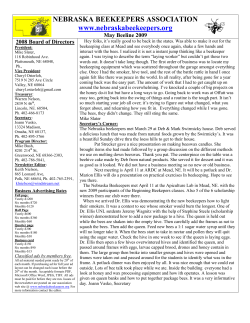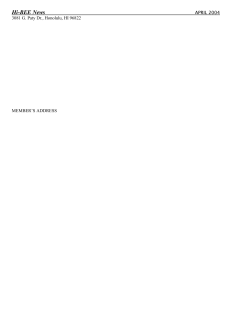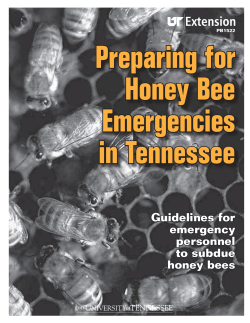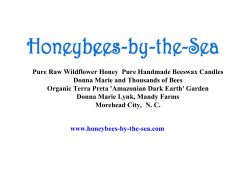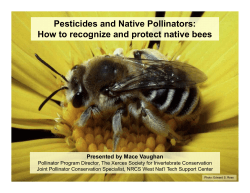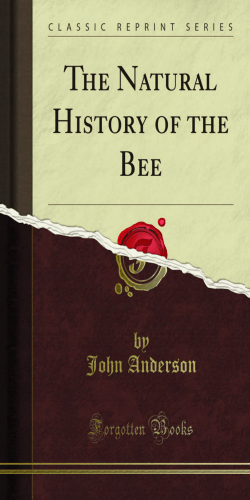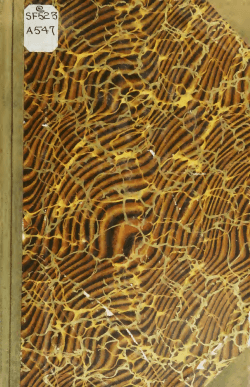
How Do Bees Make Honey
How Do Bees Make Honey Khalil Hamdan, Apeldoorn, The Netherlands The colony of the honey bee The honeybees are social insects living together in large group or family called a colony. The bees' nest inside the hive consists of several wax combs each containing many cells in which bees use for rearing their baby bees and to store food. The bees organize their affairs so well in their dwelling and devote themselves to the welfare and survival of their colony. A bee colony is made of three different castes: A queen, worker bees who form the great majority of the colony and the drones. The queen is the mother of the colony whose only function is to lay eggs from which all bees develop. The sole function of the drones is to fertilize the virgin queens, whereas the worker bees perform all tasks that the colony needs. In summer the colony contains 40,000 to 80,000 worker bees and a few hundred drones and in winter about 10,000 to 20,000 worker bees and no drones. Bees born in spring or in summer live on the average no more than six weeks, whereas those born in September or later live six months and more. This seasonal variability in the life span of individuals is due to the fact that spring or summer bees do much work with a lot of energy spent, and that those emerge in autumn stay inactive within the hive huddled together in a cluster during the wintertime and eat the stored food. A worker bee, after emerging from her birth cell as a mature bee lives approximately six weeks in summer, spending the first three weeks of her life inside the hive and is termed a house bee or nurse bee. In this stage she cleans cells, feeds the older and young bees, feeds the queen, builds wax combs, stores nectar and seals the honey cells, removes debris and dead bees, ventilates the hive and guards the hive entrance. After this period she becomes a field bee (forager) and works the second half of her life outside the hive collecting nectar, pollen, propolis and water. Bees are vegetarians. They eat two kinds of food, honey and pollen; honey is made from the nectar of the flowers and provides the bees with carbohydrate. The pollen is derived from the anthers of flowers and is the source of protein, vitamins and minerals. Honey making Making honey is the most important job of foraging bees. They fly diligently and tirelessly every day from morning till dusk in all directions and at various heights and at a distance of 3 to 5 kilometers from the hive prospecting for plants and trees producing nectar which they collect from the heart of flowers. Nectar is the basic raw product from which honey is made. It is a mixture of water and sugar that flowers produce from their nectaries. Nectar contains 20 to 60% sugars generally cane sugar. The water content varies between 40 to 80%. Besides sugar, nectar contains minerals, organic acids, vitamins, pigments and aromatic substances. Bees generally collect nectar in the warm months of the year, from spring through to autumn. A honey bee collecting nectar from a plum flower. (Photo by P-O Gustafsson) Both foragers and nurse bees are involved in the process of honey making. The process begins when a forager leaves the hive looking for flowers to collect nectar. When a flower is found, the bee sucks the nectar out of the flower with her proboscis (tongue) and stores it in a special sack in her body called the honey stomach to be transferred to the honey-making bees in the hive. The honey stomach holds about 4 mg of nectar that is about half the weight of the bee. If the nectary is empty the bee flies to another flower. A bee may need to visit between 50 to 150 flowers in order to fill her honey stomach depending on the flower species. For instance, a load can be obtained from a few rich-nectar producing flowers such as eucalyptus or citrus whereas a load can be obtained by visiting hundreds of small flowers of clover. It takes about 30 minutes to several hours to collect a load, depending on how plentiful and how far away the nectar source is. A forager may take hours to collect a load in poor foraging conditions. When the honey stomach is full the bee flies back to the hive. On her way back the bee adds invertase, an enzyme from her body to the collected nectar. This begins the process of changing the nectar into honey. The enzyme breaks the complex plant sugar in the nectar down into simpler and more digestible sugars for the bees, mainly glucose (grape sugar) and fructose (fruit sugar). A close-up view of the proboscis, the organ with which a worker bee sucks up nectar and water. (Photo by Ken Cheng) An illustration of internal anatomy of a bee showing the honey sac. (Image www.infovisual.info) In the hive the nectar is delivered to the house bees who store it in the honeycomb cells. In the cells water has to be evaporated off the nectar. House bees on the comb fan their wings to evaporate and thicken the nectar converting it into honey. Ripened honey has moisture of 17 to 20%. Further enzymes added to prevent it from fermentation and attack by bacteria while it is stored in the hive. Once this process is finished the house bees will then cover the top of each filled up cell with a thin beeswax cap to make it airtight, sealing it for future use. When this is done, they move to the next empty comb starting all over again. Busy bees on a honeycomb ripening honey. (Photo by Betty McAdam, Hog Bay Apiary, Australia Sealed ripe honey. (Photo courtesy Betty McAdam, Hog Bay Apiary, Australia) A typical colony can produce 30 to 50 kg of surplus honey per year. The bees in the same colony visit about 4 million flowers to make one kilogram of honey. The honeys they produce vary in color, flavor and viscosity; this difference depends upon the floral source from which the nectar was derived. The nectar from some plants produces a light, mild flavored honey. Nectar from other plants produces a dark, strong flavored honey. Honeybees will go on collecting and storing more nectar as long as there is nectar available in the pasture and there are empty cells in the hive to store it in, however much abundance of honey the hive contains. A returning forager with load of nectar makes her way to the combs and begins to inform the others about the source and direction of nectar to recruit more foragers to the area of nectar. She does so by performing special movements on the surface of the comb known as “dance” and does that for seconds or a minute. While she is dancing some bees gather closely around her and learn from the dance and touch her with their antennae. The dancing forager makes stops to give nectar to those bees following and watching the dance to learn its scent and taste. The dancer then runs to another place on the combs and repeats the dance before another group of bees. After the dance has ended, she makes another trip to the source of nectar, and those bees who have followed the dance leave the hive to search for the nectar. When the recruited bees return to the colony with load they in their turn recruit more bees. Foragers perform different dances to convey different information. When the source of nectar is near the hive i.e., less than 100 meters away the forager will perform a round dance, and if is far away the bee will perform the waggle dance. The round dance During the round dance the bee runs around in a little circle first one way, then turns round and runs in the opposite direction of the circle. The round dance tells the bees that the food is near the hive and of its taste and smell, but gives no information about the direction of the food source. The waggle dance Unlike the simple round dance, the more complex waggle dance gives accurate information about both the direction and distance of the nectar source. The bee uses the sun’s position to indicate the direction of the nectar. In a world the waggle dance indicates the position of the sun, the location of the hive and the spot where nectar can be found. The dance can be described as a half-circle, a straight line, a half-circle to the right and a half-circle to the left and so on. During the straight run the bee wags her abdomen from side to side to indicate distance to the nectar source, and the longer the trip to the nectar source the quicker the waggles of the dance and greater their number. If the nectar source and the sun are in the same direction, the bee runs the straight line between the two half-circles with her head up towards the sun indicating to the bees ‘you can find the nectar by flying toward the sun’. If the nectar source and the sun are in opposite direction the bee runs the straight line with her head down indicating the nectar source is opposite the direction of the sun. If the nectar is at the right or left of the sun, the bee orients the straight run of here dances at the right or left of the vertical on the comb. The Waggle dance. (Photo courtesy of Howstuffworks.com) Why do bees make honey? Bees make honey as food for themselves and for their offspring. It provides them with the energy they need for their flights to a field, and heat to keep their bodies and dwelling warm; and for the secretion of wax for comb building. Bees store surplus honey for a rainy day and feed on this honey all year round for their survival, particularly during the cold winter months when no flowers and nectar available. An average colony requires about 40 to 100 kg of honey to maintain itself through a year. Bees store extra honey for future use. (Photo courtesy Patrick Laslett, www.norfolkhoney.co.uk) References: Eva Crane. Honey: A comprehensive survey. London, 1979 I. Khalifman, Bees. Moscow, 1953 R. Morse & T. Hooper. The illustrated encyclopedia of beekeeping. 1985 Karl von Frisch. Bees: Their vision, Chemical senses, and Language, 1978 J L. Gould & G G. Gould. The Honeybee. 1988
© Copyright 2025

